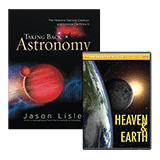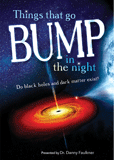Are Stars Still Forming Today?
Astronomy
The secular media often report new evidence of stars in the process of formation. They say this supports star evolution. What do creationists think?
Most astronomers believe that the universe began in a big bang nearly 14 billion years ago, but they believe most stars can’t be that old because they would burn out. So astronomers generally assume that most of today’s stars formed after the origin of the universe. Indeed, they take it for granted that many stars are still forming even today.
How do those who believe in biblical creation respond to this?
What’s Clear from the Bible
Biblically, we understand that God made the heaven, Earth, the sea, “and all that is in them” in six days (Exodus 20:11). This would include the stars.
The Bible’s short timespan doesn’t allow time for stars to form out of condensed gas clouds, as the secular model requires. For instance, astronomers believe that a star like the sun requires 30 million years to form from a collapsing gas cloud. Furthermore, the Bible does not describe the origin of stars, sun, and the Earth in the same order as the secular model. Genesis 1 explains that the Earth was made three days before the sun and stars, while the secular model puts the sun and most stars first.
Knowing that God completed the creation in six days and rested on the seventh, many biblical creationists believe that no stars have been forming since the Creation Week. But is this warranted?
A Changing Universe
Some creation astronomers have suggested an analogy between stars and animals, such as horses. God made the original horse “kind” on Day Six and hasn’t made any new kinds of creatures since. Yet new horses are born to replace the ones that die.
Might stars also be replaced as they age and “die”? Notice that neither situation requires that God supernaturally create as He did during the Creation Week. Also notice that neither case proceeds in a purely naturalistic way, but instead they follow God-ordained processes.
However, stars were never alive to begin with, so perhaps this isn’t a very good analogy. A better analogy may be the physical features on the earth. Even though God ceased creating on Day Six, we occasionally see islands, mountains, rivers, and canyons form today. For instance, a volcano abruptly appeared in a Mexican corn field in 1943, and the island of Surtsey popped up near Iceland in 1963.
Could stars occasionally form in a similar manner today?
Possibilities and Problems
For a very long time astronomers have suggested that stars form from the contraction of gas clouds in space. These clouds are made of the same material as stars, but the clouds are much larger, cooler, and far less dense. Astronomers surmise that the gas cloud’s own gravity could make it contract. As the cloud contracts, it would get smaller, warmer, and denser, slowly transitioning into a star.
But this scenario has problems. One large problem is that clouds also possess pressure, and the pressure counterbalances gravity. We say that gas clouds are “stable against collapse.”
Astronomers have long recognized this problem and devised a number of ways to get around it. Interestingly, all of their solutions require that other stars already exist. For example, a shockwave from a supernova explosion could compress a gas cloud so that it contracted to form new stars. Even if we observed a gas cloud collapsing today, that still doesn’t explain how the original stars formed by natural processes.
We haven’t actually observed star formation in a telescope, but we do see a variety of gas clouds with different densities and temperatures. Are some of these gas clouds “snapshots” of various stages of stellar formation, or are they simply a variety of celestial objects that God created?
We need to be careful not to read our own speculations into God’s Word. If we conclude from the Bible that stars don’t form now, why wouldn’t we conclude the same about islands, mountains, or canyons?
Creationists may not have biblical reasons to deny that some physical processes might form stars today, but we reject the idea that present-day processes could explain the ultimate creation of stars.
Too Many Stars
Ironically, most astronomers now think that stars formed at a much higher rate in the early universe when no stars existed. This amounts to asserting that some unknown mechanism formed many stars after the supposed big bang. That is hardly a scientific explanation.
We have no reason to believe that stars form at a high rate. Nothing that we observe today indicates that stars form regularly.
The only reason astronomers propose such a high rate is the vast number of stars they must explain (most recently estimated to be 300 billion trillion, or a 3 followed by 23 zeroes). Fourteen billion years isn’t enough time to explain so many stars unless it was an everyday occurrence.
We must realize that secular astronomers are driven by naturalistic assumptions, which they want to explain even if present-day evidence doesn’t support them. One assumption is the big bang. Another is the gradual formation of stars. A third is the time involved in both the big bang and star formation. None of these have been observed.
Underlying all of this is the belief that natural processes are the only way to explain origins. While some Christians embrace these naturalistic assumptions, they fail to see that at their root they exclude a Creator and hence undermine belief in God and His Word.
God could have made gas clouds already in the process of collapse to form stars, or God could have ordained processes whereby stars occasionally form. Yet these do not support a purely naturalistic origin of stars.
As an astronomer and biblical creationist, do I believe that stars form today? I’m not sure. I understand both sides of the biblical arguments. I don’t see that the Bible absolutely precludes star formation today, nor do I see that the Bible demands it. So I suggest a continuing discussion of this question.
Answers Magazine
April – June 2014
A closer look at the Genesis Flood account reveals a beautifully written, unified narrative that points to one inspired author. The passage masterfully highlights one central message: “God remembered Noah.” Along with in-depth articles on the Flood, this issue shows biblical and historical evidences of Christ’s Resurrection, new discoveries about the miracle of a butterfly’s metamorphosis and much more!
Browse Issue SubscribeRecommended Resources

Answers in Genesis is an apologetics ministry, dedicated to helping Christians defend their faith and proclaim the good news of Jesus Christ.
- Customer Service 800.778.3390
- © 2024 Answers in Genesis






